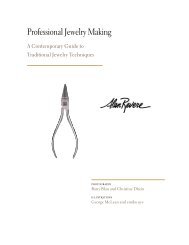Jewelry Illustration - Brynmorgen Press
Jewelry Illustration - Brynmorgen Press
Jewelry Illustration - Brynmorgen Press
Create successful ePaper yourself
Turn your PDF publications into a flip-book with our unique Google optimized e-Paper software.
1.1.4.2 Ring with Oval Ornament<br />
A<br />
B<br />
C<br />
Fig. 7<br />
Draw the centerlines.<br />
A. front and top views<br />
– On the front view, draw the two<br />
concentric circles that depict the<br />
shank.<br />
– Project their dimensions to the top<br />
view.<br />
– On the top view, define the width of<br />
the shank with two horizontals located<br />
on opposite sides of the horizontal<br />
centerline and equidistant to<br />
it.<br />
– Draw the oval. Because it is centered,<br />
the centerlines coincide with<br />
the existing lines.<br />
– Project the left and right ends of the<br />
oval’s horizontal diameter to meet<br />
the inside curve on the front view.<br />
– On the front view, define the height<br />
of the ornament with a horizontal.<br />
B. side view<br />
– From the top view, project the<br />
points representing the width of the<br />
shank and the length of the oval.<br />
– From the front view, project the<br />
elevations of the shank and ornament.<br />
– Draw the side view, but leave the<br />
lower curve of the ornament undefined<br />
until the next step.<br />
C. side view – curve<br />
– Define the lower curve of the ornament.<br />
This is the curve that rests on<br />
the finger.<br />
– Mark a series of reference points<br />
along the perimeter of the oval<br />
in the top view. One point lies at<br />
each end of the vertical diameter,<br />
one at the left end of the horizontal<br />
diameter, and two others along a<br />
single imaginary vertical placed in<br />
between. The precise placement of<br />
these last two points is not critical.<br />
– Project these points from the top<br />
view to the side view, redirecting<br />
them using a 45° angle.<br />
– Extend these same points from the<br />
top view to the inside curve of the<br />
shank on the front view.<br />
– From the front view, project these<br />
points individually to the side view<br />
to meet their corresponding verticals<br />
from the top view. These meeting<br />
points indicate the path of the<br />
curve.<br />
– Draw the curve. If the oval ornament<br />
is made from a material other<br />
than that of the shank, the portion<br />
crossing the shank is depicted using<br />
a dashed line. Otherwise, the<br />
line there is omitted.<br />
technical drawing 17




